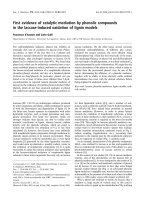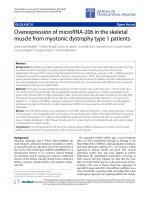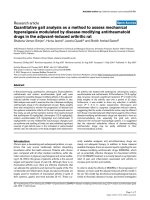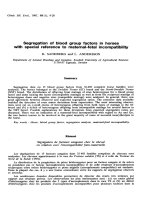MicroRNA expressions in the MPTP induced parkinsons disease model with special reference to mir 124
Bạn đang xem bản rút gọn của tài liệu. Xem và tải ngay bản đầy đủ của tài liệu tại đây (5.76 MB, 254 trang )
MICRORNA EXPRESSIONS IN THE MPTP-INDUCED PARKINSON’S
DISEASE MODEL WITH SPECIAL REFERENCE TO miR-124
NANDHINI KANAGARAJ (B.Tech.)
A THESIS SUBMITTED FOR THE DEGREE OF
DOCTOR OF PHILOSOPHY
DEPARTMENT OF ANATOMY
YONG LOO LIN SCHOOL OF MEDICINE
NATIONAL UNIVERSITY OF SINGAPORE
2013
II
08-04-2014
III
ACKNOWLEDGEMENTS
This thesis would not have been possible without the help of my supervisor
Associate Professor Tay Sam Wah Samuel, Department of Anatomy, National
University of Singapore. He has patiently guided me through my graduate
studies offering invaluable guidance, constant encouragement in my scientific
pursuits and the motivation to work hard and smart. He has been an
inspirational role model and his values and principles will stay with me for a
long time to come. I am honored to express my earnest thanks to him for being
a wonderful mentor and I will always look up to his ideals and guidance.
I am highly grateful and indebted to Associate Professor Thameem S
Dheen, Department of Anatomy, National University of Singapore for his
immense help and scientific critique throughout my course of study. His
suggestions and ideas have helped me greatly in my research for which I am
extremely grateful. His help has been indispensable in the completion of my
thesis.
I would like to express my sincere gratitude to Professor Bay Boon Huat,
Head of the Department of Anatomy, who provided me an opportunity to
work in this excellent research facility.
I would like to appreciate Ms Ng Geok Lan, Ms.Yong Eng Siang and Ms
Chan Yee Gek for their valuable assistance in the labs. I would also like to
thank Mr Yick Tuck Yong, Ms Carolyne, Ms Violet Teo and Ms Diljit Kour,
who have been of great help by providing their secretarial assistance.
I must mention my labmates Mrs Meenalochani and Ms Ooi Yin Yin for
their friendly help and support through my PhD course. I extend my deepest
IV
thanks to all the staff and students in the Department of Anatomy for
providing a friendly and cooperative working environment.
I would like to thank Dr Makoto Yawata, Singapore Institute of Clinical
Sciences for allowing me to use the laser capture microdissection equipment
and providing all the help and guidance in carrying out the experiment.
There are no words to thank my beloved parents Kanagaraj and Latha and
my lovely sister Janani for being a constant source of encouragement and
support. Without their love I wouldn’t have been where I am now. My uncle
Raghavan and aunt Vellaithai are the ones who encouraged me to pursue my
PhD and provided me with all the help and support to start off. It is my duty to
thank them at this point. My in-laws have supported me immensely through
the last year of my study and I must thank them for their patience and
understanding.
My husband, Selva Vijaya Kumar, has been my pillar of strength and
without his love, constant motivation and understanding I am not sure I would
have completed the writing of this thesis.
All my friends in Singapore and India have been with me through my
highs and lows and made all these years memorable and joyous. My heartfelt
love and thanks to all of them.
Last but not least, I thank God for all the good things and opportunities he
has given to me in my life.
V
Dedicated to my beloved parents, sister and my husband
VI
PUBLICATIONS
Various portions of the present study have been presented, submitted for
publication or under preparation for publication.
Research articles
Nandhini Kanagaraj, He Beiping, S Thameem Dheen, Samuel, Sam
Wah Tay. Downregulation of miR-124 in MPTP-treated mouse model
of Parkinson’s disease and MPP+ treated MN9D cells modulates the
expression of the calpain/cdk5 pathway proteins. (Under review in
Neuroscience).
Nandhini Kanagaraj, Yawata M, He Beiping, S Thameem Dheen,
Samuel, Sam Wah Tay. Dysregulated microRNA and mRNA networks
in the substantia nigra of MPTP-treated mice. (Manuscript under
preparation).
Nandhini Kanagaraj*, Yue Li*, S Thameem Dheen, Samuel, Sam
Wah Tay. Stage and sub-field associated microRNA changes in
epilepsy. (Manuscript under preparation).
Conference abstracts
Nandhini Kanagaraj, S.T.Dheen, Z.F.Peng, D. Srinivasan, SSW Tay.
MicroRNA-124 and its target genes are altered in the MPTP-induced
Parkinson’s disease model. Experimental Biology 2012, San Diego,
United States. 21-25 April 2012 (Oral presentation).
Kanagaraj, N., Dheen, S. T., Peng, Z. F., Srinivasan, D. K., & Tay, S.
S. W. (2012). MicroRNA-124 and its target gene are altered in the
substantia nigra (SNc) of the brain of MPTP-mouse model of
Parkinson's disease. The FASEB Journal, 26(1_MeetingAbstracts),
83.86.
Nandhini Kanagaraj, S.T.Dheen, SSW Tay. miR-124 loss leads to
upregulation of calpain/cdk5 pathway proteins in the Parkinson’s
disease model in vitro and in vivo. SNA symposium 2013 (Best Oral
presentation award).
Nandhini Kanagaraj, Yue Li, S Thameem Dheen, Sam Wah Samuel
Tay. Stage and sub-Field associated microRNA changes in Epilepsy.
Experimental Biology 2013, Boston, United States. 20-24 April
2013.(Poster presentation).
VII
Kanagaraj N, Li Y, Dheen ST, Tay SS (2013) Stage and Sub-Field
associated microRNA changes in Epilepsy. The FASEB Journal
27:533.537.
Nandhini Kanagaraj, S Thameem Dheen, Samuel Sam Wah Tay.
MicroRNA-124 contributes to calpain-mediated cdk5 activation in the
MPTP-induced Parkinson’s disease model. Neurodegenerative diseases
meeting, Cold Spring Harbor Laboratories, New York, United States.
28 November- 1 December 2012 (Poster presentation)
SSW Tay, Nandhini Kanagaraj. Role of miR-124 in dopaminergic
neurons of MPTP-induced Parkinson’s disease model and in vitro. 2
nd
International Anatomical Sciences and Cell Biology Conference
(IASCBC 2012), Chiang Mai, Thailand. 6-8 December 2012.
Nandhini Kanagaraj, S.T.Dheen, SSW Tay. Downregulation of miR-
124 in the MPTP-induced Parkinson’s disease mouse model and MPP+
treated MN9D cells modulates the expression of the calpain/cdk5
pathway proteins. 3
rd
YLLSOM Graduate Scientific Congress 2012.
January 2013 (Poster presentation).
Nandhini Kanagaraj, Z.F.Peng, B.P. He, S.T.Dheen, SSW Tay.
Altered expressions of microRNA-124 and its target CREB in the
substantia nigra of MPTP-induced Parkinson’s disease model. 2
nd
YLLSOM Graduate Scientific Congress 2012. January 2012 (Poster
presentation).
VIII
TABLE OF CONTENTS
DECLARATION………………………………………………………………I
ACKNOWLEDGEMENTS III
PUBLICATIONS VI
SUMMARY XIX
LIST OF TABLES XXIV
LIST OF ILLUSTRATIONS/TEXT FIGURES XXV
ABBREVIATIONS XXVI
INTRODUCTION 1
1.1 Parkinson’s disease 2
1.2 Epidemiology 3
1.3 Clinical characteristics and diagnosis 5
1.4 Neuropathological characteristics 6
1.5 Etiology of PD 7
1.5.1 Aging and PD 8
1.5.2 Environmental factors 8
1.5.3 Genetic factors in PD 11
1.5.3.1 SNCA 11
1.5.3.2 LRRK2 12
1.5.3.3 Parkin 13
IX
1.5.3.4 PINK1 14
1.5.3.5 PARK7 or DJ-1 15
1.5.3.6 ATP13A2 15
1.5.3.7 Other genes with role in PD 15
1.5.3.8 Risk factor genes 16
1.6 Mechanisms of cell death in PD 16
1.6.1 Mitochondrial dysfunction 18
1.6.2 Oxidative stress 18
1.6.3 Excitotoxicity 20
1.6.4 Neuroinflammation 20
1.7 Animal models of Parkinson’s disease 21
1.7.1 MPTP model 23
1.8 Epigenetic mechanisms in PD 27
1.8.1 DNA methylation 28
1.8.2 Histone modifications 30
1.8.3 MicroRNA 30
1.9 Overview of microRNAs 31
1.9.1 Biogenesis of microRNAs 32
1.9.1.1 miRNA genomics 32
1.9.1.2 Transcription and processing 32
1.9.2 Mechanism of action 36
X
1.9.2.1 Cleavage of target mRNA 36
1.9.2.2 Deadenylation of mRNA 36
1.9.2.3 Translational repression 37
1.10 Principles of target recognition 38
1.11 MicroRNAs in PD 38
1.12 Aims of the present study 43
1.13.1 To investigate the degeneration of dopaminergic neurons in the
SNc of MPTP-treated mice 44
1.13.2 To establish an in vitro model of PD using MN9D dopaminergic
neuronal cell line 45
1.13.3 To study miRNA expression changes in the SNc of MPTP-treated
mice…… 46
1.13.4 To study the role of miR-124 in MPTP-induced dopaminergic
neuronal death. 47
1.13.5 To identify PD-associated target genes and pathways of the
dysregulated miRNAs 48
MATERIALS AND METHODS 49
2.1 Animals 50
2.2 MPTP treatment 50
2.2.1 Materials required 50
2.2.2 Injections 50
2.3 Isolation of brain samples 51
XI
2.3.1 Fresh brain samples for RNA isolation 51
2.3.2 Perfusion 51
2.4 Isolation of the substantia nigra 52
2.5 Cell culture 52
2.5.1 Materials required 52
2.5.2 Cell culture maintenance 52
2.6 MPP iodide treatment 53
2.6.1 Materials required 53
2.6.2 Cell differentiation 53
2.6.3 MPP+ treatment 53
2.7 Protein extraction 54
2.7.1 Materials required 54
2.7.2 Protein extraction 54
2.8 Estimation of protein concentration 54
2.8.1 Materials required 54
2.8.2 Procedure 54
2.9 Western Blotting 55
2.9.1 Materials Required 55
Equipment 55
10% Resolving gel 56
5% Stacking gel 56
XII
6x SDS gel loading buffer 56
10X Tris buffered saline (TBS) 56
1X Tris buffered saline tween (TBST) 57
2.9.2 Procedure 58
2.10 RNA isolation 58
2.10.1 Materials required 58
2.10.2 Procedure 58
2.10.2.1 RNA isolation from tissue samples 58
2.10.2.2 RNA isolation from cells 59
2.10.2.3 RNA isolation from Laser capture microdissected tissue 59
2.11 cDNA synthesis 60
2.11.1 Materials required 60
2.11.2 Procedure 60
2.12 Real time RT-PCR 60
2.12.1 Materials required 60
2.12.2 Procedure 61
2.13 cDNA synthesis for miRNA 61
2.13.1 Materials required 61
2.13.2 Procedure 61
2.14 microRNA PCR 62
2.14.1 Materials required 62
XIII
2.14.2 Procedure 62
2.15 Cryosectioning 62
2.16 Nissl staining (Cresyl-fast violet staining) 63
2.16.1 Materials required 63
2.16.2 Procedure 63
2.17 Immunofluorescence and immunohistochemistry studies 63
2.17.1 Materials required 63
2.17.2 Procedure 64
2.17.2.1 Immunofluorescence in vivo 64
2.17.2.2 Double immunofluorescence labeling in vivo 65
2.17.2.3 Immunohistochemistry 65
2.17.2.4 Immunofluorescence in vitro 65
2.18 In situ hybridization 66
2.18.1 Materials required 66
2.18.2 Procedure 66
2.19 Knockdown studies 67
2.19.1 Materials required 67
2.19.2 Procedure 68
2.20 Overexpression studies 68
2.20.1 Materials required 68
2.20.2 Procedure 68
XIV
2.21 Extracellular ROS/RNS and H
2
O
2
assay 69
2.22 Cell viability assay 69
2.23 Laser Capture Microdissection 70
2.23.1 Materials required 70
2.23.2 Procedure 70
2.24 Staining for LCM 71
2.24.1 Materials required 71
2.24.2 Procedure 71
2.25 MicroRNA qPCR profiling 72
2.25.1 Materials required 72
2.25.2 Procedure 72
2.26 Mouse Parkinson’s Disease PCR array 73
2.26.1 Materials required 73
2.26.2 Procedure 73
2.26.2.1 cDNA synthesis and preamplification 73
2.26.2.2 PCR array 75
2.26.2.3 Data analysis 75
2.27 IPA analysis of miRNA profiling data 75
2.28 Statistical analysis 76
RESULTS 77
3.1 The acute MPTP-induced PD mouse model 78
XV
3.1.1 Neuronal loss 78
3.1.1.1 Nissl staining 78
3.1.1.2 Tyrosine hydroxylase immunostaining 78
3.1.2 Tyrosine hydroxylase and dopamine transporter gene expression
changes 79
3.1.3 Proinflammatory cytokines in the SNc of MPTP-treated animals 79
3.1.4 Inducible nitric oxide synthase (iNOS) expression 80
3.2 MN9D dopaminergic cells 80
3.3 Laser capture microdissection 81
3.4 MicroRNA qPCR profiling 81
3.5 qPCR analysis of specific miRNAs in the SNc of MPTP-treated mice 81
3.5.1 miR-204-5p expression 82
3.5.2 Expression of miR-129-3p 82
3.5.3 Expression pattern of miR-342-3p 82
3.5.4 miR-9-5p expression 83
3.5.5 miR-125b-5p expression 83
3.5.6 Expression of miR-128-3p 83
3.5.7 Expression pattern of miR-24-3p 83
3.5.8 miR-30b and miR-30c 83
3.6 Role of miR-124 in the MPTP-PD model 84
XVI
3.6.1 miR-124 expression in the MPTP-lesioned mice and MPP+ treated
MN9D cells 84
3.6.2 Calpains 1 and 2- predicted targets of miR-124 85
3.6.3 Calpain 1 and calpain 2 expression in MPTP-treated mouse SNc 85
3.6.4 Transfection of miR-124-inhibitor 85
3.6.5 Expression of calpain 1 and calpain 2 in MPP iodide-treated and
miR-124 knockdown MN9D cells 86
3.6.6 Expression of p35 and p25 increased on MPP iodide treatment and
miR-124 knockdown 86
3.6.7 Increased cdk5 expression 87
3.6.8 Calpain 1 expression increased significantly after miR-124 target
protector transfection 87
3.6.9 Studies on overexpression of miR-124 in MN9D cells 88
3.6.10 ROS/RNS and H2O2 production and MN9D cell viability after
knockdown or overexpression of miR-124 88
3.7 miRNA target prediction 89
3.7.1 Parkinson’s disease PCR array 89
3.7.2 PD-specific target mRNAs of the deregulated miRNAs 90
3.7.3 Targets of upregulated miRNAs 90
3.7.4 Targets of downregulated miRNAs 91
DISCUSSION 92
4.1 Pathological changes in the acute MPTP-induced PD mouse 93
XVII
4.2 MPTP induces TH and DAT gene expression changes 94
4.3 Proinflammatory genes are upregulated in the SNc of MPTP-treated
mice… 95
4.4 MN9D cell line as a model for PD in vitro 97
4.5 Laser capture microdissection helps efficiently isolate the SNc region97
4.6 miRNA expression is modulated in the SNc upon MPTP treatment 98
4.7 miRNA expressions change with time after MPTP-treatment. 99
4.8 Effect of miR-124 down-regulation in the dopaminergic neurons 103
4.9 Pathways and genes modulated by upregulated miRNAs 107
4.9.1 Dopamine signaling pathway 107
4.9.2 miRNAs targeting LRRK2 110
4.9.3 α-synuclein and miRNAs 111
4.9.4 GABA
B
receptor 2 and miRNAs 112
4.10 Pathways and genes modulated by the downregulated miRNAs 113
4.10.1 Mitochondrial dysfunction 114
4.10.2 Protein ubiquitination 115
CONCLUSIONS AND FUTURE DIRECTIONS 117
REFERENCES 123
FIGURES AND FIGURE LEGENDS 177
XVIII
XIX
SUMMARY
XX
Parkinson’s disease (PD) is the second most common neurodegenerative
disease, after Alzheimer’s disease, which primarily affects the elderly. PD is a
result of the loss of dopaminergic neurons in the substantia nigra pars
compacta (SNc) which is also accompanied by the formation of aggregates of
α-synuclein called Lewy bodies. The major symptoms of PD are associated
with motor function which includes tremor, rigidity, postural instability and
bradykinesia. Being a complex disorder caused by a combination of genetic
and environmental factors, developing therapeutics which can cure PD has
remained elusive. The existing treatment options only provide symptomatic
relief and cause severe side effects on long term use. Hence, an enhanced
understanding of the molecular mechanisms involved in the pathogenesis of
PD can aid in the development of better treatment options to cure the disease.
The degeneration of the SNc dopaminergic neurons induced by 1-methyl-4-
phenyl-1,2,3,6-tetrahydropyridine (MPTP) has been well documented and
widely used to model PD in animals. Several processes involved in human PD
pathogenesis are found to be altered in the MPTP-induced PD models.
However, the mechanisms involved in the dopaminergic neuronal
degeneration are not completely understood.
The foremost aim of the present study was to establish an acute MPTP-
induced PD mouse model. The loss of dopaminergic neurons and changes in
gene expression of tyrosine hydroxylase (TH) and dopamine transporter
(DAT), both important genes in the dopamine synthesis and uptake
mechanism were analysed in the SNc of MPTP-induced PD mice as compared
to controls. Time-dependent reduction in the number of dopaminergic neurons
and the expression of TH and DAT were observed as seen at different time-
XXI
points after MPTP treatment. Since PD involves a complex interplay of
several pathogenic processes, the expression of proinflammatory genes,
tumour necrosis factor-α (TNFα) and interleukin-1β (IL1β) were assessed at
different time points to demonstrate the role of inflammation in the acute
MPTP-model of PD. An increased expression of both the genes during the
first few days after MPTP treatment which gradually decreases with time
provides evidence for the role of inflammation in the MPTP-induced
dopaminergic neuronal death. Increased nitric oxide (NO) has been shown to
induce cell death and the increased expression of the inducible nitric oxide
synthase (iNOS) and its colocalization with TH-immunopositive neurons at
early time points after MPTP treatment suggests that the iNOS enzyme plays
an important role in initiating the degeneration of dopaminergic neurons.
MicroRNAs (miRNAs) are small, non-coding RNAs known to play important
regulatory roles in several cellular processes. The role of miRNAs in the
maintenance of normal cellular functions and in disease-inducing pathways
has been increasingly demonstrated. Owing to the difficulty in obtaining
human PD brain tissues and the variations in the time of obtaining the PD
tissues, there have been very few studies on the involvement of miRNAs in
PD. A detailed analysis of miRNA expression changes in the MPTP-model
could thus provide insights into similar miRNA changes occurring in human
PD. Hence, the next aim was to identify miRNA expression changes in the
SNc of MPTP-induced mice (sacrificed on day 5 after MPTP treatment)
isolated by laser capture microdissection (LCM) as compared to the control
mice. Expression profiling by qPCR revealed differential expression of 74
miRNAs between the control and MPTP-treated mice, among which 36 were
XXII
upregulated and 38 were downregulated. Analyzing the expression of a few of
these miRNAs in the SNc of MPTP-treated and control mice at different time
points after MPTP treatment, it was observed that the expression levels varied
at different time points. This indicates that MPTP induces time-dependent
expression changes in miRNAs thereby suggesting a role for miRNAs in the
degenerative process.
Among the differentially expressed miRNAs, miR-124 (a brain-abundant
miRNA) was found to be downregulated from the profiling data. Analysis of
miR-124 expression at different time points indicated a time-dependent
downregulation of expression which was evident from 24h after MPTP
treatment. The miR-124 is predicted to target the calpains 1 and 2 which are
known to play a role in the neuronal death in human PD and MPTP-induced
PD models by altering the expression and activity of cyclin-dependent kinase
5 (cdk5). The expression of calpains 1 and 2 was found to be increased in the
SNc of MPTP-induced mice and MPP iodide-treated MN9D dopaminergic
neuronal cells. Loss of function studies by transfecting MN9D cells with miR-
124 inhibitors showed that miR-124 contributes to the increased expression of
calpain 1, p35/p25 and cdk5 along with a marginal increase in reactive oxygen
and nitrogen species (ROS/RNS) and hydrogen peroxide (H
2
O
2
) while also
compromising the viability of the cells. Gain of function analysis was
performed using miR-124 mimics. miR-124 overexpression in MPP iodide-
treated MN9D cells was capable of attenuating the expression of calpain 1,
p35/p25 and cdk5 accompanied by reduced neuronal death. Calpain 1 target
protector studies revealed that miR-124 acts by interacting with the calpain 1
XXIII
mRNA. Taken together, these results suggest an important role for miR-124 in
the survival of dopaminergic neurons in the MPTP-induced PD model.
In order to analyze the significance of the miRNA expression changes in the
MPTP-induced PD model, a PD-specific PCR array of 84 genes known to play
a role in PD pathogenesis was performed. The miRNA and mRNA profiles
were analyzed to identify miRNA targets among the differentially expressed
PD-specific mRNAs. The analysis revealed that several of the differentially
expressed mRNAs were targets of the dysregulated miRNAs. The miRNAs
and target mRNAs were mainly involved in dopamine signaling,
mitochondrial dysfunction and protein ubiquitination pathways. Further, genes
like α-synuclein (SNCA), leucine-rich repeat kinase 2 (LRRK2), PTEN-
induced kinase 1 (PINK1) and PARK7 which are known to play prominent
roles in PD pathogenesis are targeted by the dysregulated miRNAs identified
by the miRNA profiling.
Hence, the results of the present study show that miRNA expression levels in
the SNc are altered as a result of MPTP treatment. The dysregulated miRNAs
target several important genes shown to be involved in the pathogenesis of PD
and modulate pathways shown to be altered in PD. However, detailed analysis
of individual miRNAs and their targets is essential to elucidate the exact role
of each altered miRNA in the MPTP-induced PD pathogenesis.
XXIV
LIST OF TABLES
Table 1
List of miRNAs associated with Parkinson’s disease
40
Table 2
List of primary and secondary antibodies used in
Western blotting analysis
57
Table 3
List of primary and secondary antibodies used in
immunostaining
64
Table 4
Real-time cycler program for cDNA preamplification
74
Table 5
RT-PCR program for PCR array
75
Table 6
List of dysregulated miRNAs in the SNc of MPTP-
treated mice identified by qPCR profiling
221-222
Table 7
List of dysregulated mRNAs in the SNc of MPTP-
treated mice identified by qPCR profiling
223-224
Table 8
List of top diseases and cellular functions involving
the upregulated miRNAs and downregulated mRNAs
identified by IPA analysis
225
Table 9
List of top diseases and cellular functions involving
the downregulated miRNAs and upregulated mRNAs
identified by IPA analysis
226
XXV
List of Illustrations/Text Figures
Fig I.
Biological processes and genes implicated in PD
17
Fig II.
The chemical structure of 1-methyl-1,2,3,6-
tetrahydropyridine (MPTP) and 1-methyl-4-
phenylpyridinium (MPP
+
) ion.
24
Fig III.
Mechanism of action of MPTP
27
Fig IV.
Biogenesis and transcription of miRNAs
35
Fig V
Illustration of miR-124-mediated modulation of calpain
1/cdk5 pathway.
121









